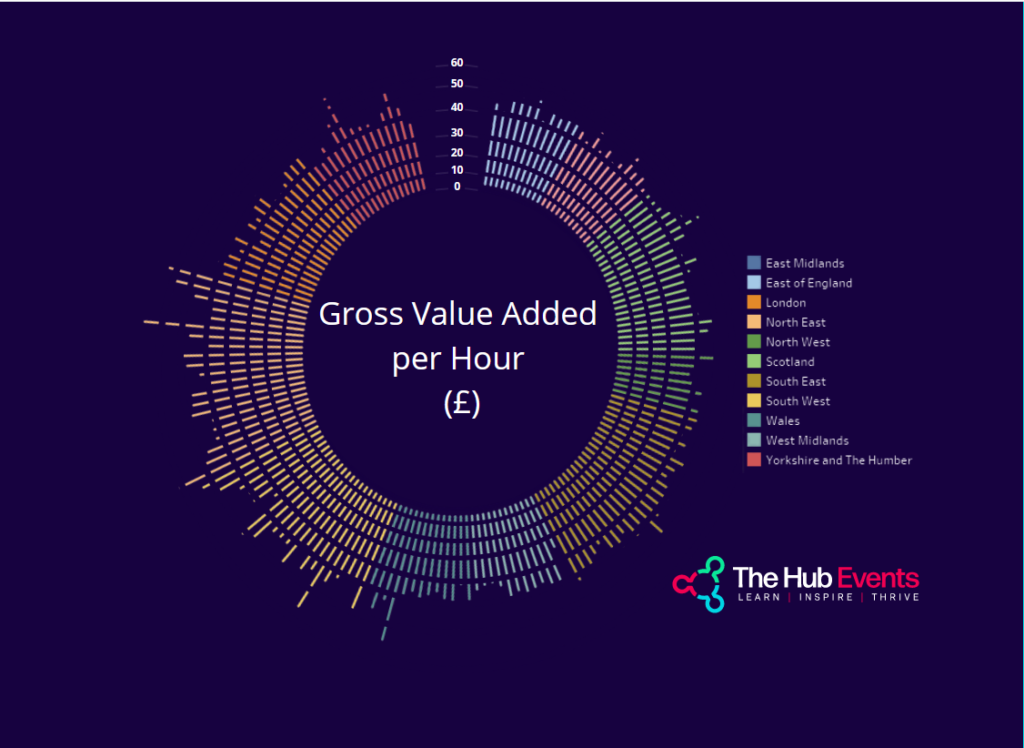UK’s 10 Most Productive Regions Revealed

British workers are coming into the second year of the pandemic with a stronger notion of what they want their careers to look like. ‘The Great Resignation’, a term coined by Professor Anthony Klotz, is an event that has left over 1.2 million job vacancies in the UK, an increase of over 400,000 from its pre-pandemic levels.
This has opened up the UK for those willing to travel around the country to find jobs where their time is worth more. Not every region pays out the same, and we have scoured through ONS data to discover how much your time is worth. This was done by comparing the Gross Value Added (GVA) of each UK region. The GVA is an economic productivity metric that allows for easy comparison between how much value is added to the economy per hour worked.
Using this data, the team at The Hub Events discovered the most productive regions and made the infographic below.
It’s no surprise that the home of the Crown Jewels, the HSBC tower and Barclays bank headquarters was ranked the most productive region in the UK. Tower Hamlets had an average Gross Value added of £60.50 per hour. This is 3 times higher than Powys in Wales which was ranked as the least productive region with a GVA of £20.30 per hour.
That’s not to say one area works more than another, it is that working for an hour in Tower Hamlets would contribute three times as much to the economy than working for an hour in Powys.
Out of the top 20 most productive subregions, 12 were in London, 6 were in the South East, then there was the City of Edinburgh in Scotland, Solihull in the West Midlands and Swindon in the South West. Moving away from London, we have listed the 10 most productive regions in the UK outside of the capital.
1. North Hampshire
Topping the list of most productive regions is North Hampshire. With military towns like Aldershot, also known as the “Home of the British Army”, within its borders, there is lots of money to be had from the concentration of young, predominantly male soldiers nearby. Being only a short commute from London, there is also a high proportion of people with London wages to spend. With all these factors in play, it’s no surprise why the North Hampshire region topped this list.
2. Berkshire
You might think that being the home of Windsor Castle may have something to do with why Berkshire is so high on this list. However, the team at Hub Events place more stock in the fact that Berkshire is the base for high tech industries. Reading, in particular, has had historical ties with Information technology industries. Whilst those industries no longer exist, they have been swallowed up by companies like Hewitt-Packard, Siemens and Microsoft, which all have headquarters in the county.
3. Swindon
Home to the UK Space agencies head office, Swindon is no stranger to high tech businesses opening up shop. Until recently, it was a centre of excellence for 3G and 4G mobile telecommunications research and development for Motorola, Nokia Siemens Networks and Cisco. With the up and coming 5g technology, there’s a chance for Swindon to jump up this list with more and higher quality industries.
4. Solihull
Solihull has often been touted as the shopping capital of the UK. In 2014 the town was listed as one of the top five destinations for shopping in the UK. To highlight the quality of the brands represented here, look no further than the type of people that the National Exhibition Centre brings in. This centre hosts a number of national trade shows, such as The Horse of the Year Show and The Crufts International Dog Show.
5. West Surrey
Surrey as a whole has more organisation and company headquarters than any other county in the UK. You have industry titans like Canon, Toshiba, Samsung and Philips, which all have headquarters there. It is also home to some of the most successful NGO’s like the World Wild Fund for Nature (WWF). This combined with the high proportion of residents working in the financial sector, it’s no wonder that the average wages and the GVA is high in Surrey.
6. Milton Keynes
Milton Keynes has one of the most successful economies in the UK, ranked third (by gross value added per worker) for its contribution to the national economy. However, our ranking is done by hour worked and in this metric it ranked 12th. Milton Keynes is home to several national and international companies, most notable of which is Argos, Domino’s Pizza, and Mercedes-Benz. It’s clear to see how so many big names would mean your work contributes more to the economy as a whole.
7. East Surrey
Losing out to Its Western counterpart by just over £1 of GVA per hour, East Surrey came in 7th. As with before, Surrey is home to more organisations and company headquarters than any other county in the UK. Some of the largest multinationals in the world have their UK and European headquarters here, including Unilever, Superdrug and Nestlé.
8. City of Edinburgh
The Scottish capital is the only place outside of England to make it on the top 10 list. It has the highest gross value added per employee of any city in the UK outside London and is one of the strongest economies outside of London. This isn’t surprising as it has the highest percentage of professionals in the UK with 43% of the population holding a degree-level or professional qualification.. Unfortunately, that doesn’t translate into hours worked, where the GVA added per hour is £41.90.
9. Cheshire East
The chemical industry in Cheshire has been ongoing since the times of the Romans, with the mining of salt in Middlewich and Northwich. Salt is still mined in this area but in this modern age it is done by British Salt and not men in togas. Chesire East has also moved into the modern age with it’s thriving petroleum industry, although for how long that will last is another question entirely.
10. West Kent
West Kent has had a long history of being the origin for many of London’s commuters. This proximity to the capital often tends itself to higher wages from these commuters, which translates into a higher average GVA per hour worked. It also means that Kent has a higher than average construction and transportation industry as they are constantly developing their infrastructure. Infrastructure is often the surefire way of developing the economy.
When having a close look at all these regions, it is often difficult to see a pattern. However, when combined into the traditional NUTS1 regions, we can see the bigger picture. When combined and averaged out, the regions in London and South West were the only ones in the UK that have a higher GVA per hour than the UK average of £35.70. Wales is the worst ranking region at only £28.60 GVA added per hour.




